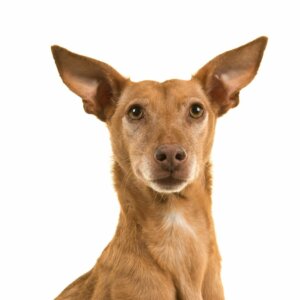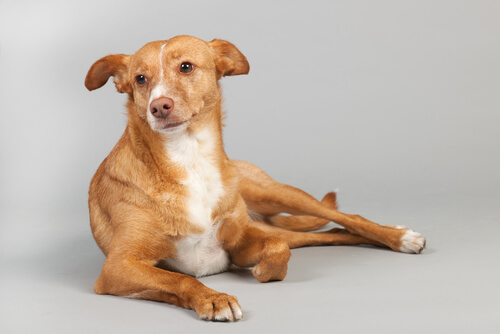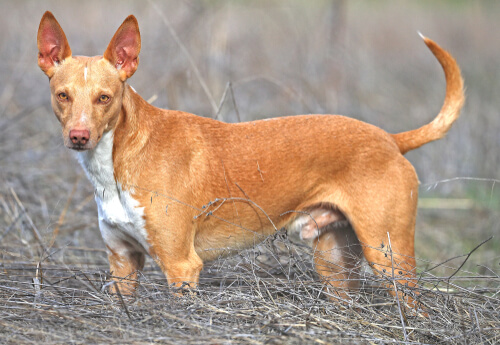The Podenco Canario: All About this Breed


Written and verified by the biologist Cesar Paul Gonzalez Gonzalez
The Podenco Canario, also called the Canary Islands Hound, is a very popular dog breed in the Canary Islands thanks to its fabulous hunting abilities. It’s well known for obeying the commands of its owners, and for being an excellent companion. In addition, it has an interesting origin and a strong resemblance to the god Anubis of the Egyptian culture.
The Podenco Canario is characterized by being a medium-sized dog with great energy. It belongs to group 7 of the classification proposed by the Federation Cinologique Internationale, which also includes the Retriever and the English Pointer. Keep reading this article and learn more about this curious breed.
Origin of the breed
The Podenco Canario is native to the Canary Islands where they can be easily found, although they predominate in the islands of Gran Canaria and Tenerife.
It’s believed that they arrived in these areas about 7 thousand years ago by means of the first settlers, who used them as another tool for hunting. With the passage of time, the domestication of this breed was completed and it became the affectionate dog it is today.
The real unknown about this dog is its origin before arriving to the Canary Islands. This seems to be answered thanks to different genetic analyses, but, above all, by the discovery of some ancestors of the canine in pharaonic tombs. As you can see, the Podenco Canario seems to have Egyptian ancestry!
This breed is considered one of the oldest of all, and there are even some engravings, statues and bas-reliefs that you can find exhibited in museums such as the Louvre and the British Museum. Nowadays, this dog is recognized as an excellent breed for field work and, in the Canary Islands, it’s popular for its hunting activities.

Podenco Canario: Characteristics
This dog can measure between 53 and 64 centimeters (20 to 25 inches) in height, with a weight of 20 to 25 kilograms (44 to 55 pounds). Its body is slender and very strong, as its muscles need to be powerful for the activities it has to perform. The distinctive characteristics of the breed are the muzzle, the extremities, and its elongated ears, in addition to its tail that has a curvature just at the end.
Dogs of this type have a short, thick coat that protects them from the sun, as this is an advantage for hunting activities. Their coloring is usually reddish-brown, although there are more variations with red and white tones as a base.
Personality
The personality of the Podenco Canario is closely related to the origin of its breed. They’re very attentive to its owners, but can be perceived as a nervous or restless dogs due to the amount of energy they have. However, they aren’t aggressive at all and remain docile most of the time. They’re perfect companions for long days of physical work.
It doesn’t have guard dog characteristics, as its peaceful nature makes it get along well with almost any person or dog. They develop very strong bonds with their owners. Of course, this also depends on whether they have had good socialization during their upbringing.
General care
The physical appearance of this dog is very imposing, so it isn’t possible to have it in small homes such as apartments. You need to have ample space for them to run and enjoy the outdoors. If not, the anxiety of confinement and lack of exercise will start to cause behavioral problems.
Dogs used in hunting also need to be stimulated with specific games, so that they develop all the innate abilities they possess. Keep in mind that training can be a bit challenging for the owners. For this reason, before adopting a Podenco Canario, make sure you’ll have enough time to raise and train it well.
The coat of this breed isn’t too difficult to maintain. The most important thing is to make sure you brush it at least once a week. This will be enough to clean it and keep its appearance in optimal condition. Remember that dogs’ baths shouldn’t be too frequent, and so you should only bathe it if it’s really necessary.

Common diseases
This breed doesn’t usually have too many health problems. Despite this, some dogs may exhibit congenital problems due to keeping the breed “pure”. The most common ailments in the Podenco Canario are the following:
- SRY-negative (hermaphroditism): A very rare disease that results in the presence of mixed-sex organs (male and female).
- Otitis: Infections of the skin of the ear. It isn’t as frequent in dogs with erect ears such as this breed. However, some studies indicate that the breed may be susceptible to chronic otitis caused by fungus.
- Hip dysplasia: A condition that causes instability in the bones of the hip and femur, causing them to wear out, thus impairing mobility.
The Podenco Canario is one of the most imposing breeds that exists, but it requires specific care in order for it to have a healthy life. If you have decided to one of these dogs, then make sure that it will fit in with your life and ability to look after and train it. Having a pet is a great responsibility that not everyone can bear. However, it’s one of the best experiences you can have in life.
The Podenco Canario, also called the Canary Islands Hound, is a very popular dog breed in the Canary Islands thanks to its fabulous hunting abilities. It’s well known for obeying the commands of its owners, and for being an excellent companion. In addition, it has an interesting origin and a strong resemblance to the god Anubis of the Egyptian culture.
The Podenco Canario is characterized by being a medium-sized dog with great energy. It belongs to group 7 of the classification proposed by the Federation Cinologique Internationale, which also includes the Retriever and the English Pointer. Keep reading this article and learn more about this curious breed.
Origin of the breed
The Podenco Canario is native to the Canary Islands where they can be easily found, although they predominate in the islands of Gran Canaria and Tenerife.
It’s believed that they arrived in these areas about 7 thousand years ago by means of the first settlers, who used them as another tool for hunting. With the passage of time, the domestication of this breed was completed and it became the affectionate dog it is today.
The real unknown about this dog is its origin before arriving to the Canary Islands. This seems to be answered thanks to different genetic analyses, but, above all, by the discovery of some ancestors of the canine in pharaonic tombs. As you can see, the Podenco Canario seems to have Egyptian ancestry!
This breed is considered one of the oldest of all, and there are even some engravings, statues and bas-reliefs that you can find exhibited in museums such as the Louvre and the British Museum. Nowadays, this dog is recognized as an excellent breed for field work and, in the Canary Islands, it’s popular for its hunting activities.

Podenco Canario: Characteristics
This dog can measure between 53 and 64 centimeters (20 to 25 inches) in height, with a weight of 20 to 25 kilograms (44 to 55 pounds). Its body is slender and very strong, as its muscles need to be powerful for the activities it has to perform. The distinctive characteristics of the breed are the muzzle, the extremities, and its elongated ears, in addition to its tail that has a curvature just at the end.
Dogs of this type have a short, thick coat that protects them from the sun, as this is an advantage for hunting activities. Their coloring is usually reddish-brown, although there are more variations with red and white tones as a base.
Personality
The personality of the Podenco Canario is closely related to the origin of its breed. They’re very attentive to its owners, but can be perceived as a nervous or restless dogs due to the amount of energy they have. However, they aren’t aggressive at all and remain docile most of the time. They’re perfect companions for long days of physical work.
It doesn’t have guard dog characteristics, as its peaceful nature makes it get along well with almost any person or dog. They develop very strong bonds with their owners. Of course, this also depends on whether they have had good socialization during their upbringing.
General care
The physical appearance of this dog is very imposing, so it isn’t possible to have it in small homes such as apartments. You need to have ample space for them to run and enjoy the outdoors. If not, the anxiety of confinement and lack of exercise will start to cause behavioral problems.
Dogs used in hunting also need to be stimulated with specific games, so that they develop all the innate abilities they possess. Keep in mind that training can be a bit challenging for the owners. For this reason, before adopting a Podenco Canario, make sure you’ll have enough time to raise and train it well.
The coat of this breed isn’t too difficult to maintain. The most important thing is to make sure you brush it at least once a week. This will be enough to clean it and keep its appearance in optimal condition. Remember that dogs’ baths shouldn’t be too frequent, and so you should only bathe it if it’s really necessary.

Common diseases
This breed doesn’t usually have too many health problems. Despite this, some dogs may exhibit congenital problems due to keeping the breed “pure”. The most common ailments in the Podenco Canario are the following:
- SRY-negative (hermaphroditism): A very rare disease that results in the presence of mixed-sex organs (male and female).
- Otitis: Infections of the skin of the ear. It isn’t as frequent in dogs with erect ears such as this breed. However, some studies indicate that the breed may be susceptible to chronic otitis caused by fungus.
- Hip dysplasia: A condition that causes instability in the bones of the hip and femur, causing them to wear out, thus impairing mobility.
The Podenco Canario is one of the most imposing breeds that exists, but it requires specific care in order for it to have a healthy life. If you have decided to one of these dogs, then make sure that it will fit in with your life and ability to look after and train it. Having a pet is a great responsibility that not everyone can bear. However, it’s one of the best experiences you can have in life.
All cited sources were thoroughly reviewed by our team to ensure their quality, reliability, currency, and validity. The bibliography of this article was considered reliable and of academic or scientific accuracy.
- FEDERATION CYNOLOGIQUE INTERNATIONALE. (1987 ). Estándar-FCI N° 329 PODENCO CANARIO . Recuperado el 20 de diciembre de 2021, disponible en: http://www.fci.be/nomenclature/Standards/329g05-es.pdf
- Hernández Peraza, C. (2019). ¿Caza o casa? El debate sobre el Podenco en Canarias. (Tésis de grado, Universidad de La Laguna)
- Morales Doreste, M. F., González Lama, Z., Martín Barrasa, J. L., Tejedor Junco, M. T., & Lupiola Gómez, P. A. (2001). Relación entre la presencia de Malassezia Pachydermatis y los signos clínicos encontrados en cuadros de otitis crónicas caninas en una población de perros de raza Podenco canarios. Clinica veterinaria de pequeños animales.
- González, A., Luque, M., Rodero, E., González, C., Aguilera, R., Jiménez, J., … & Herrera, M. (2011). Use of morphometric variables for differentiating Spanish hound breeds. Int. J. Morphol, 29(4), 1248-1255.
- Buijtels, J. J. C. W. M., De Gier, J., Van Haeften, T., Kooistra, H. S., Spee, B., Veldhuis Kroeze, E., … & Okkens, A. C. (2009). Minimal External Masculinization in a SRY‐negative XX Male Podenco Dog. Reproduction in domestic animals, 44(5), 751-756.
This text is provided for informational purposes only and does not replace consultation with a professional. If in doubt, consult your specialist.








